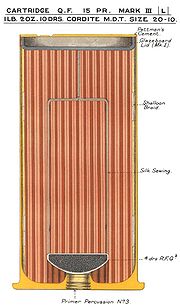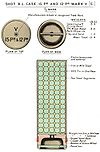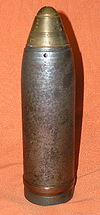
Ordnance QF 15 pounder
Encyclopedia
The Ordnance QF 15 pounder gun, commonly referred to as the Ehrhardt, was a modern German field gun purchased by Britain in 1900 as a stopgap measure to upgrade its field artillery to modern QF standards, while it developed its own alternative. It bore no relation to the BL 15 pounder
or BLC 15 pounder
, two other guns in British service at the time, other than a common shell.
It replaced the obsolete BL 12 pounder 6 cwt gun
in Royal Horse Artillery
service until the QF 13 pounder
became available from 1904.
When the Territorial Force
was formed in 1908 the guns were assigned to its cavalry units, known as Yeomanry. The axle-tree seats were removed as unnecessary because the gunners rode horses, and gun-shields were added. The modified carriage was designated Mk I+.
This gun is the "15 pounder" to which writers are referring in World War I if they are referring to RHA
batteries of the Territorial Force
, or Yeomanry. The other "15 pounder", the BLC 15 pounder
, was an unrelated gun used by field artillery
batteries of the Territorial Force
, although it was also issued to some second line RHA batteries raised in 1914.
batteries of Territorial Force
cavalry units (Yeomanry
) early in World War I
, most notably in the campaign in Egypt against the Senussi by A Battery Honourable Artillery Company
and the Nottinghamshire Battery of the RHA
.
B Battery of Honourable Artillery Company
and Berkshire Battery, RHA
were in action with these guns in the recapture of Sheik Othman (key to the water supply to Aden) from the Turks on 20 July 1915, part of the Aden campaign.
From 1916 the QF 15 pounder was replaced by the modern 13 pounder
and 18 pounder
.
Ordnance BL 15 pounder
The Ordnance BL 15 pounder, otherwise known as the 15 pounder 7 cwt, was the British Army's field gun in the Second Boer War and some remained in limited use in minor theatres of World War I.-History:...
or BLC 15 pounder
Ordnance BLC 15 pounder
The Ordnance BLC 15 pounder gun was a modernised version of the obsolete BL 15 pounder 7 cwt gun, incorporating a recoil and recuperator mechanism above the barrel and modified quicker-opening breech...
, two other guns in British service at the time, other than a common shell.
History
The gun as originally designed and supplied to Britain had a sprung telescoping trail to assist with recoil control, all-steel wheels, axle-tree seats and no shield. The British found the trail unsatisfactory in service, so they permanently pinned it in the closed position. The British also immediately replaced the original all-steel wheels with standard British wooden spoked wheels.It replaced the obsolete BL 12 pounder 6 cwt gun
Ordnance BL 12 pounder 6 cwt
The Ordnance BL 12 pounder 6 cwt was a lighter version of the British 12 pounder 7 cwt gun, used by the Royal Horse Artillery. The "6 cwt" referred to the weight of the gun and barrel to differentiate it from other 12 pounders guns...
in Royal Horse Artillery
Royal Horse Artillery
The regiments of the Royal Horse Artillery , dating from 1793, are part of the Royal Regiment of Artillery of the British Army...
service until the QF 13 pounder
Ordnance QF 13 pounder
The Ordnance QF 13-pounder quick-firing field gun was the standard equipment of the British Royal Horse Artillery at the outbreak of World War I.-History:...
became available from 1904.
When the Territorial Force
Territorial Force
The Territorial Force was the volunteer reserve component of the British Army from 1908 to 1920, when it became the Territorial Army.-Origins:...
was formed in 1908 the guns were assigned to its cavalry units, known as Yeomanry. The axle-tree seats were removed as unnecessary because the gunners rode horses, and gun-shields were added. The modified carriage was designated Mk I+.
This gun is the "15 pounder" to which writers are referring in World War I if they are referring to RHA
Royal Horse Artillery
The regiments of the Royal Horse Artillery , dating from 1793, are part of the Royal Regiment of Artillery of the British Army...
batteries of the Territorial Force
Territorial Force
The Territorial Force was the volunteer reserve component of the British Army from 1908 to 1920, when it became the Territorial Army.-Origins:...
, or Yeomanry. The other "15 pounder", the BLC 15 pounder
Ordnance BLC 15 pounder
The Ordnance BLC 15 pounder gun was a modernised version of the obsolete BL 15 pounder 7 cwt gun, incorporating a recoil and recuperator mechanism above the barrel and modified quicker-opening breech...
, was an unrelated gun used by field artillery
Royal Field Artillery
The Royal Field Artillery of the British Army provided artillery support for the British Army. It came into being when the Royal Artillery was divided on 1 July 1899, it was reamalgamated back into the Royal Artillery in 1924....
batteries of the Territorial Force
Territorial Force
The Territorial Force was the volunteer reserve component of the British Army from 1908 to 1920, when it became the Territorial Army.-Origins:...
, although it was also issued to some second line RHA batteries raised in 1914.
Combat service
The gun was used by Royal Horse ArtilleryRoyal Horse Artillery
The regiments of the Royal Horse Artillery , dating from 1793, are part of the Royal Regiment of Artillery of the British Army...
batteries of Territorial Force
Territorial Force
The Territorial Force was the volunteer reserve component of the British Army from 1908 to 1920, when it became the Territorial Army.-Origins:...
cavalry units (Yeomanry
Yeomanry
Yeomanry is a designation used by a number of units or sub-units of the British Territorial Army, descended from volunteer cavalry regiments. Today, Yeomanry units may serve in a variety of different military roles.-History:...
) early in World War I
World War I
World War I , which was predominantly called the World War or the Great War from its occurrence until 1939, and the First World War or World War I thereafter, was a major war centred in Europe that began on 28 July 1914 and lasted until 11 November 1918...
, most notably in the campaign in Egypt against the Senussi by A Battery Honourable Artillery Company
Honourable Artillery Company
The Honourable Artillery Company was incorporated by Royal Charter in 1537 by King Henry VIII. Today it is a Registered Charity whose purpose is to attend to the “better defence of the realm"...
and the Nottinghamshire Battery of the RHA
Royal Horse Artillery
The regiments of the Royal Horse Artillery , dating from 1793, are part of the Royal Regiment of Artillery of the British Army...
.
B Battery of Honourable Artillery Company
Honourable Artillery Company
The Honourable Artillery Company was incorporated by Royal Charter in 1537 by King Henry VIII. Today it is a Registered Charity whose purpose is to attend to the “better defence of the realm"...
and Berkshire Battery, RHA
Royal Horse Artillery
The regiments of the Royal Horse Artillery , dating from 1793, are part of the Royal Regiment of Artillery of the British Army...
were in action with these guns in the recapture of Sheik Othman (key to the water supply to Aden) from the Turks on 20 July 1915, part of the Aden campaign.
From 1916 the QF 15 pounder was replaced by the modern 13 pounder
Ordnance QF 13 pounder
The Ordnance QF 13-pounder quick-firing field gun was the standard equipment of the British Royal Horse Artillery at the outbreak of World War I.-History:...
and 18 pounder
Ordnance QF 18 pounder
The Ordnance QF 18 pounder, or simply 18-pounder Gun, was the standard British Army field gun of the World War I era. It formed the backbone of the Royal Field Artillery during the war, and was produced in large numbers. It was also used by British and Commonwealth Forces in all the main theatres,...
.
Ammunition
54,000 complete rounds (i.e. shell, fuze, cartridge) of German design and manufacture were originally supplied with the guns. These were replaced by British manufactures when used up. The following diagrams show British-made ammunition available in 1914. |
 |
 |
 |
 |
|

